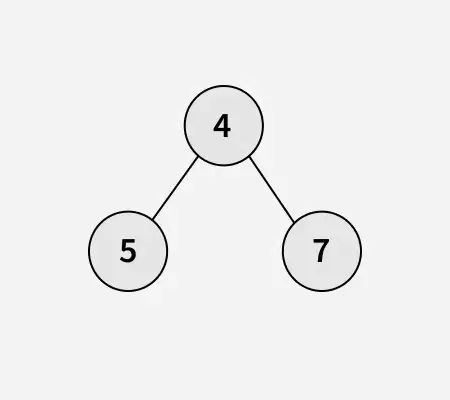Atsižvelgiant į an n-arinis medis kuriose yra teigiamų mazgų verčių, užduotis yra rasti gylis medžio.
Pastaba: An n-arinis medis yra medis, kuriame gali turėti kiekvienas mazgas nulis arba daugiau vaikų mazgai. Skirtingai nuo dvejetainio medžio, kurio viename mazge yra daugiausia du vaikai (kairėje ir dešinėje) n-arinis medis leidžia kelios šakos arba vaikai kiekvienam mazgui.
Pavyzdžiai:
Įvestis:
Išvestis: 3
Paaiškinimas: Ilgiausias kelias nuo šaknies (81 mazgo) iki lapo yra 81 -> 26 -> 95 arba 81 -> 26 -> 86, o didžiausias gylis yra 3.Įvestis:

Išvestis: 2
Paaiškinimas: Ilgiausias kelias nuo šaknies (4 mazgo) iki bet kurio lapo (5 arba 7 mazgai) yra 2, nes tam reikia tik dviejų lygių.intellij idėja vs užtemimas
Prieiga:
Idėja yra apskaičiuoti N ilgio medžio gylis rekursyviai inicijuoti maksimalus gylis kaip 0, tada rekursyviai apskaičiuokite gylis kiekvienam vaikui ir sekite didžiausias gylis susidūrė. Galiausiai pridėkite 1 iki didžiausio gylio (dabartiniam mazgui) ir grąžinkite rezultatas . Šis požiūris užtikrina, kad rasime ilgiausias kelias nuo šaknies iki bet kurio lapo mazgo.
N-Ary medį galima kirsti kaip ir įprastą medį. Mes tiesiog turime atsižvelgti į visus tam tikro mazgo vaikus ir rekursyviai iškviesti šią funkciją kiekviename mazge.
C++// C++ Code to find the depth of an N-ary tree #include
// Java Code to find the depth of an N-ary tree import java.util.*; class Node { int data; List<Node> children; Node(int val) { data = val; children = new ArrayList<>(); } } // Recursive function to calculate // maximum depth class GfG { static int maxDepth(Node root) { // If the node is null depth is 0 if (root == null) { return 0; } int depth = 0; // Recur for all children and find // the maximum depth for (Node child : root.children) { depth = Math.max(depth maxDepth(child)); } // Add 1 to include the current node // in the depth count return depth + 1; } public static void main(String[] args) { // Representation of given N-ary tree // 1 // / | // 2 3 4 // / // 5 6 Node root = new Node(1); root.children.add(new Node(2)); root.children.add(new Node(3)); root.children.add(new Node(4)); root.children.get(0).children.add(new Node(5)); root.children.get(2).children.add(new Node(6)); System.out.println(maxDepth(root)); } }
# Python Code to find the depth # of an N-ary tree class Node: def __init__(self val): self.data = val self.children = [] # Recursive function to calculate # maximum depth def max_depth(root): # If the node is None depth is 0 if not root: return 0 depth = 0 # Recur for all children and # find the maximum depth for child in root.children: depth = max(depth max_depth(child)) # Add 1 to include the current # node in the depth count return depth + 1 if __name__ == '__main__': # Representation of given N-ary tree # 1 # / | # 2 3 4 # / # 5 6 root = Node(1) root.children.append(Node(2)) root.children.append(Node(3)) root.children.append(Node(4)) root.children[0].children.append(Node(5)) root.children[2].children.append(Node(6)) print(max_depth(root))
// C# Code to find the depth of an N-ary tree using System; using System.Collections.Generic; class Node { public int data; public List<Node> children; public Node(int val) { data = val; children = new List<Node>(); } } // Recursive function to calculate // maximum depth class GfG { static int MaxDepth(Node root) { // If the node is null depth is 0 if (root == null) { return 0; } int depth = 0; // Recur for all children and find the maximum depth foreach (Node child in root.children) { depth = Math.Max(depth MaxDepth(child)); } // Add 1 to include the current // node in the depth count return depth + 1; } static void Main(string[] args) { // Representation of given N-ary tree // 1 // / | // 2 3 4 // / // 5 6 Node root = new Node(1); root.children.Add(new Node(2)); root.children.Add(new Node(3)); root.children.Add(new Node(4)); root.children[0].children.Add(new Node(5)); root.children[2].children.Add(new Node(6)); Console.WriteLine(MaxDepth(root)); } }
// JavaScript Code to find the depth // of an N-ary tree class Node { constructor(val) { this.data = val; this.children = []; } } // Recursive function to calculate // maximum depth function maxDepth(root) { // If the node is null depth is 0 if (!root) { return 0; } let depth = 0; // Recur for all children and find // the maximum depth for (let child of root.children) { depth = Math.max(depth maxDepth(child)); } // Add 1 to include the current node // in the depth count return depth + 1; } // Representation of given N-ary tree // 1 // / | // 2 3 4 // / // 5 6 const root = new Node(1); root.children.push(new Node(2)); root.children.push(new Node(3)); root.children.push(new Node(4)); root.children[0].children.push(new Node(5)); root.children[2].children.push(new Node(6)); console.log(maxDepth(root));
Išvestis
3
Laiko sudėtingumas: O(n), nes kiekvienas mazgas aplankomas vieną kartą, kur n yra bendras mazgų skaičius N-ame medyje.
Pagalbinė erdvė: O(h) čia h yra medžio aukštis dėl rekursyvaus skambučių krūvos naudojimo.


